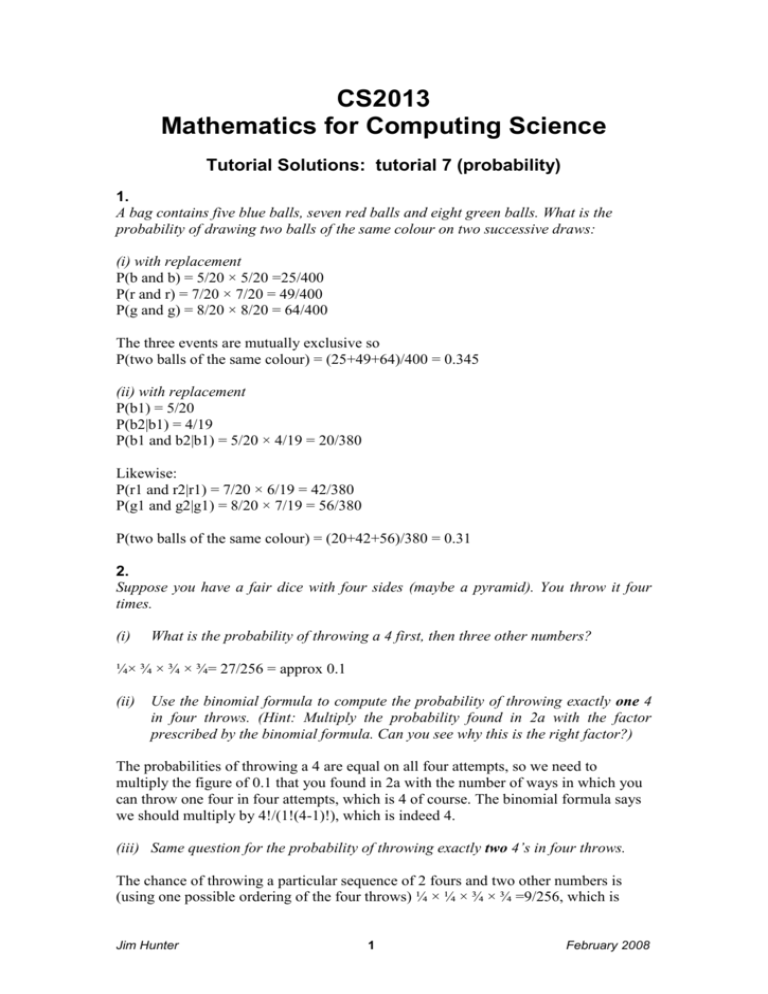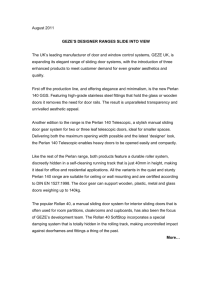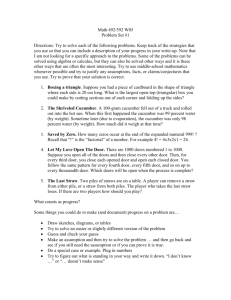Solutions in MsWord
advertisement

CS2013 Mathematics for Computing Science Tutorial Solutions: tutorial 7 (probability) 1. A bag contains five blue balls, seven red balls and eight green balls. What is the probability of drawing two balls of the same colour on two successive draws: (i) with replacement P(b and b) = 5/20 × 5/20 =25/400 P(r and r) = 7/20 × 7/20 = 49/400 P(g and g) = 8/20 × 8/20 = 64/400 The three events are mutually exclusive so P(two balls of the same colour) = (25+49+64)/400 = 0.345 (ii) with replacement P(b1) = 5/20 P(b2|b1) = 4/19 P(b1 and b2|b1) = 5/20 × 4/19 = 20/380 Likewise: P(r1 and r2|r1) = 7/20 × 6/19 = 42/380 P(g1 and g2|g1) = 8/20 × 7/19 = 56/380 P(two balls of the same colour) = (20+42+56)/380 = 0.31 2. Suppose you have a fair dice with four sides (maybe a pyramid). You throw it four times. (i) What is the probability of throwing a 4 first, then three other numbers? ¼× ¾ × ¾ × ¾= 27/256 = approx 0.1 (ii) Use the binomial formula to compute the probability of throwing exactly one 4 in four throws. (Hint: Multiply the probability found in 2a with the factor prescribed by the binomial formula. Can you see why this is the right factor?) The probabilities of throwing a 4 are equal on all four attempts, so we need to multiply the figure of 0.1 that you found in 2a with the number of ways in which you can throw one four in four attempts, which is 4 of course. The binomial formula says we should multiply by 4!/(1!(4-1)!), which is indeed 4. (iii) Same question for the probability of throwing exactly two 4’s in four throws. The chance of throwing a particular sequence of 2 fours and two other numbers is (using one possible ordering of the four throws) ¼ × ¼ × ¾ × ¾ =9/256, which is Jim Hunter 1 February 2008 approx. 1/28. This probability needs to be multiplied by the number of ways in which you can throw two fours in four trials. The binomial formula says this is the factor 4!/(2! ×2)=(4×3×2)/(2×2)=24/4=6. (Verify that this makes sense!) A good approximate answer is therefore 6×1/28= approx. 1/5. (iv) Same question for the probability of throwing exactly four 4’s in four throws. There is only one way in which one can throw four 4’s in four throws, and its probability is (1/4)4, which is 1/256. 3. What is the probability of throwing a one exactly three times in ten throws of a fair six-sided dice? . We are carrying out 10 Bernoulli trials (a trial is one throw of the dice); in each trial the probability of success is 1/6 (getting a one). X is the number of successes in 10 trials? Possible values are: 0, 1, 2, ... r, ... 10 The (binomial) distribution of X is: P(X=r) = 10 Cr × pr × (1-p)10-r We are interested in r = 3, and p = 1/6: P(X=3) = 10 C3 × (1/6)3 × (5/6)7 10 C3 = 10! /(3! × 7!) = 10 × 9 × 8 × 7 × 6 × 5 × 4 × 3 × 2 × 1 /(3 × 2 × 1 × 7 × 6 = 10 × 9 × 8 /(3 × 2 × 1) = 120 2 × 1) P(X=3) = 120 × 57 / 610 = 0.152 4. A supermarket stocks eggs in boxes of 6, and 10% of the eggs are found to be cracked. Assuming that the cracked eggs are distributed at random and that the customer selects a box at random, what is the probability that the box that the customer selects will have no cracked eggs? Here the single Bernoulli trial is examining a single egg. 'Success' is finding a cracked egg with a probability (p) of 0.1. The Binomial trial is conducting six Bernoulli trials. We are interested in the probability of getting 0 successes in 6 trials. P(x=0) = 6C0 × p0 × (1-p)(6-0) = 6!/(0! ×(6-0)!) ×(0.1) 0 × (0.9) 6 = 1 × 1 × (0.9) 6 = 0.5314 ≈ 53% Jim Hunter 2 0! = 1, p0 = 1 February 2008 5. [Discussion question] Discuss the probability of an arbitrary future football match in the Premiership ending in a draw. (The match that will decide the bet will be drawn at random.) Consider the implications of an a priori perspective (assuming that all match scores are equally likely) and an experimental perspective. A priori: See if you can shoot any holes in the following argument. The possible outcomes can be arranged in a table, where the x-axis records one team’s score (0,1, etc.) and the y-axis the other’s (0,1,etc.) Assuming that each team can score up to n goals, this table has n+1 rows and columns. Draws are the results in the main diagonal, hence n+1 draws per (n+1)^2 scores, that’s a probability of 1/(n+1). For large n, this becomes, of course, very small (negligibly small if all finite scores were possible), but for realistically low scores it’s much higher (check n=4, for example). This analysis is simplistic in that it fails to take into account the psychology of the game. For example, the fact that each team only gets 1 point for a draw (but 3 points for a victory and 0 for a loss) might make draws less likely than our analysis suggests. A posteriori (i.e., observation based): Collect data from Premiership matches in a systematic way, for example all the matches played in one football season. (This is better than all the matches in one calendar year. Why?) Then divide the number of draws by the number of matches. 6. [Discussion question] Suppose you're on a game show, and you're given a choice of three doors: Behind one door is a car; behind the other two, goats. You pick a door, say number 1, and the host, who knows what's behind the doors, opens another door, say number 3, which has a goat. He says to you, “Do you want to pick door number 2?” -- Is it to your advantage to switch your choice of doors This problem involving conditional probabilities, which has become even better known after it figured in Mark Haddon’s 2003 “The Curious Incident of the Dog in the Night-time”, looks easy but it is not. Great minds have differed about the answer, and books have been written about it. See e.g http://www.letsmakeadeal.com/problem.htm for discussion. Note that some of the “proofs” that you will see may be flawed. What’s difficult about the problem is that two equally plausible-looking arguments lead to completely different conclusions. Let Ci mean “the car is behind door i”. Let Hi mean “the host shows there to be a goat behind door i”. The possible arrangements behind doors 1,2,3 can be visualised in a table, where g means goat and c means car. Each of the three arrangements is equally probable initially: Jim Hunter 3 February 2008 123 g g c 1/3 g c g 1/3 c g g 1/3 (A longer table involving 6 instead of 3 rows could be used if we distinguish between the two goats g1 and g2, but this will not affect the arguments.) (i) Here is the first argument. After the host’s hint H3, the first combination is ruled out. Therefore, only two possibilities are left, each of which is still equally likely, having a probability of ½. 123 g c g 1/2 c g g 1/2 It follows that switching from 1 to 2 does not lead to a better probability of finding a car. [This is the outcome that probably matches many non-statisticians’ intuitions.] (ii) The second argument goes as follows. Based on the table, the following probabilities hold: P(C1)=1/3, P(C2 or C3)=2/3. After the host’s hint H3, this is still true, but we also know that C3 is false. Hence P(C2) = P(C2 or C3) = 2/3. It follows that you had better switch from door 1 to door 3, which is twice as likely to have the car behind it. [This argument was defended by the inventor of the problem and by many others after her.] At least one of the two arguments must be wrong, and possibly both, unless there is an unclarity in the statement of the problem. Interesting variants of the puzzle are obtained by increasing the number of doors. For example, there might be a million doors. After you have tentatively chosen door 1, each of the other doors except the one behind door 3 is opened and revealed to contain a goat. Argument (ii) implies that switching is now imperative, since the probability of winning a car after switching to door 3 is almost 1 (actually, 999,999/1,000,000) compared to almost 0 (1/1,000,000). Rather than defending one particular conclusion, let this be a warning that reasoning with conditional probabilities is not always as straightforward! Jim Hunter 4 February 2008








